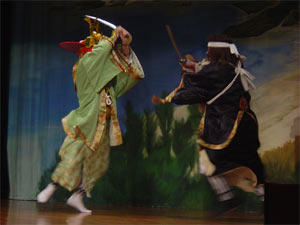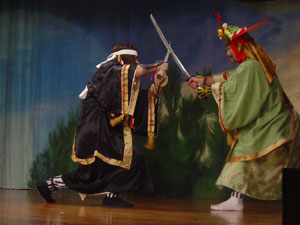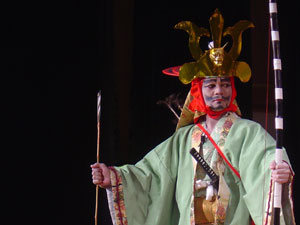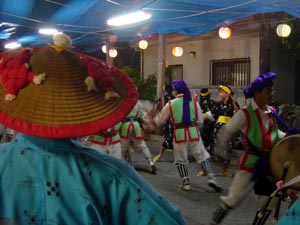kumi-odori
September 28, 2004




On Friday and Saturday of last week the island’s villages once again had festivals. This time it was the Hōnensai (豊年祭), which translates as ‘Fruitful Year Festival’. I’m not sure quite what that corresponds to in English—I would translate it as ‘harvest festival’, if it wasn’t for the fact that the harvest festivals were in August. Anyway, the Hōnensai is considerably calmer than the Unna (harvest festivals) of August. Instead of fire, copious booze, tugs-of-war and wrestling, this time round consisted mostly of music and dance performances. In particular, the village where I live put on an Okinawan Kumi-Odori (組踊) play. Like a lot of Okinawan culture, Kumi-Odori seems to be a mixture of both Japanese and Chinese influences. The closest thing to Kumi-Odori that I know of is Japanese Kabuki, but there’s a definite Chinese flavour to the brightly-coloured costumes as well.
As well as the Kumi-Odori, there was a performance of traditional Okinawan Eisa – a sort of drumming dance. It actually reminds me strangely of Morris Dancing (although it’s slower), particularly because the men’s costumes even look quite Morrissey (and I use the word ‘Morrissey’ here mainly because I get a perverse and inexplicable sort of pleasure from the idea that we might, at this point, be joined, via Google, by a small number of puzzled Smiths fans. So: Morrissey, Morrissey, Morrissey, Morrissey Morrissey, Morrissey).
One of the things I really like about Okinawa is the fact that virtually everyone seems to learn at least one traditional Okinawan art to at least a basic level — be it eisa, sanshin (banjo), folk song or karate (Okinawa’s most famous cultural export). I’m sure this dedication to preserving folk culture is at least partly because of Okinawa’s rather sad history, which has led—as a consequence firstly of being conquered by Japan and then (a couple of hundred years later) of being the scene of some of the fiercest fighting of WWII—to there being almost no surviving writings or art from the Ryūkyū (pre-Japanese) period.
Whatever the reason, the contrast with the UK is pretty stark. Since the last time I saw Morris Dancing, when I was a little kid, I don’t think I’ve heard it mentioned other than as an object of ridicule. Folk music doesn’t have it quite as bad as Morris Dancing, but it’s still definitely uncool. The sad thing is that, hip or not, there’s a rich history there that we seem to be pissing on even as we embrace the Great Monoculture of brand name t-shirts and coffee that, though mediocre, tastes reassuringly the same here as it does at home.
As well as all that high culture, I performed in a dance to a silly children’s song that seemed to be called ‘Fish Fish Fish’. With me on stage were the (very smiley) deputy head of the elementary school, my next-door neighbour Mrs. K, and a couple of dozen elementary school kids. We had cut-out paper fish stuck all over us, and the dance involved pom-poms and mime. I danced, I think, with all the requisite poise and grace.